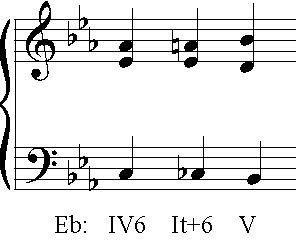
Augmented Sixth Chords
What they do: Augmented sixth chords are pre-dominant function chords, resolving to the dominant. They pull our ear to the dominant chord, much like a secondary dominant of V. The cadential six-four chord may intervene. These chords contain an augmented sixth interval which has a strong pull outward to resolve to an octave on the fifth scale degree.
How they are spelled: Augmented sixth chords are best thought of as a collection of tones on certain scale degrees, rather than having a root, third, etc. There are three main types that we will study first: Italian, German, and French. All three types include the two tones of the augmented sixth interval, and the tonic note.
The augmented sixth interval is built from the low sixth scale degree and the raised fourth scale degree. For example, in the key of C, that would be the notes A flat and F#. In minor, the sixth scale degree is already low, so an accidental is only required to raise the fourth scale degree; in major, both notes of this interval will need chromatic alteration.
In this chord, the low sixth degree is typically in the bass, so that it forms an augmented sixth interval with the raised fourth scale degree in an upper voice. An augmented sixth interval sounds just like a minor seventh, but does not resolve like a seventh. Instead, each note of the A6 interval resolves outward one half step to an octave, on the fifth scale degree – the low 6th scale degree goes down a half step to 5, and the raised 4th scale degree goes up a half step to 5. Here is an example of an augmented sixth interval resolving outward by half steps to the octave note B-flat:
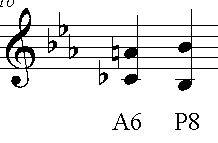
The scale degrees found in each type are:
Italian – low 6, 1, raised 4
German – low 6, 1, low 3 or raised 2, raised 4
French – low 6, 1, 2, raised 4
Because these chords all use the low 6th scale degree, and one of them contains the low 3rd scale degree, they require less chromatic alteration in the minor mode. In minor, only the 4th scale degree needs to be raised. But in major, building an augmented sixth chord may require up to 3 accidentals (German).
How they are indicated in musical analysis: Usually we indicate the type of augmented sixth chord with an abbreviation, It for Italian, Ger for German, and Fr for French, followed by the symbol +6. In other words, use the identifiers It+6, Ger+6, and Fr+6. If the chord is not one of these three types, you can just use the symbol +6.
How they sound: The Italian sounds like just the root, third and seventh of a dominant seventh chord, the German sounds exactly like a complete V7 chord, and the French sounds like a V7 chord with a flatted 5th. It is the low sixth scale degree which “sounds” like the root, even though this chord is not spelled and does not function as if this note were the root.
How they resolve: Each type has its specific resolution. But in all types, the resolution of the augmented 6th interval is the most important thing to be aware of, resolving it outward by half steps to the octave. Once those notes are resolved, it will be fairly easy to see where the other voices need to go.
The Italian augmented sixth chord, having only three tones, has the tonic note doubled in a four-voice structure. This chord resolves to V. The notes of the augmented 6th interval resolve outward by half step to make an octave on the 5th scale degree; one tonic note moves to the leading tone, and one to the 2nd scale degree, making a V triad with the root doubled. A IV6 triad makes a good approach chord, so that scale tones 4 & 6, can be moved chromatically to raised 4 and low 6, as if they were chromatic passing tones. This may be the way this chord originated.
Here is an example of this use of the Italian augmented sixth chord in the key of E-flat major, three voices. Notice how the soprano and bass notes behave like chromatic passing tones in between the IV and V chords.

The German augmented sixth chord resolves to a tonic 6/4 chord, since if was resolved to V, it would result in parallel fifths (the fifth from flat 6 to flat 3, which would descend to the fifth from 5 to 2.) As with the Italian, the augmented 6th interval resolves outward to the octave on the 5th scale degree, which is the fifth of the 6/4 chord; the tonic note is held as a common tone. The last note, the low 3rd/raised 2nd scale degree, is somewhat more complicated. If the key is minor, spell the note as low 3, the third note of the scale, and keep it as a common tone in the i6/4. This is the way the chord is used in the following example:
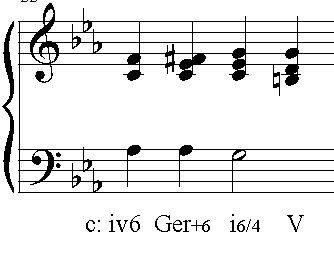
But if the tonic is major, respell this note as the raised 2nd scale degree so that it can be clear that this note should resolve upwards by half step, to the third degree of the major scale. (It is better to spell any chromatic note in a way that implies its subsequent movement: raised notes go up, lowered notes go down.) Here is the same example as above, but this time in C major, with the E-flat respelled as a D#:
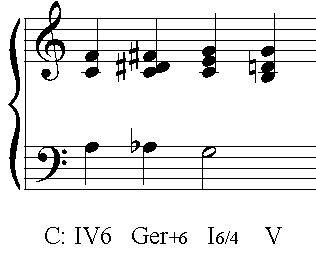
The French augmented sixth can resolve to either V or a tonic six-four chord. Again, both notes of the augmented sixth interval resolve outward by half steps to the fifth scale degree, doubling it, either as root of the V or fifth of the tonic 6/4. If moving to V, keep the second scale degree as a common tone and move the tonic note down to the leading tone; if moving to tonic six-four, keep the tonic note as a common tone and move the 2nd scale degree up to the third scale degree.
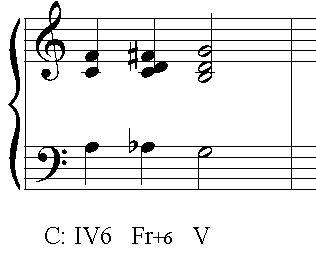
Resolving to V7 instead of V:
In consecutive chords in chromatic harmony, it is important that consecutive chromatic notes on the same letter move in the same voice. This kind of situation occurs when an augmented sixth chord resolves to V7 instead of V: the augmented sixth chord contains the raised 4th scale degree, and the V7 chord contains the regular 4th scale degree. When resolving to V7 instead of the V triad, the raised 4th scale degree needs to move down chromatically to the regular 4th degree, instead of up to the 5th scale degree. All other notes resolve as before. Use this technique with Italian and French augmented sixth chords. (German augmented 6ths do not resolve directly to V, they go to I6/4 first.)
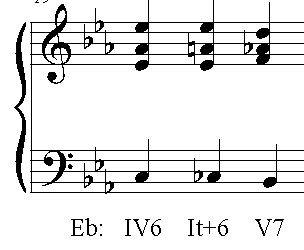
Using an augmented 6th chord as a pivot chord in modulation:
Since the German sixth chord sounds just like a dominant seventh chord, these two chord functions can be used interchangeably as a pivot chord. For example, the V7 chord in any key could be become the German sixth in a different key, or vice versa, the German sixth could be respelled to function as the dominant seventh. Since the German sixth sounds like a V7 built on the low 6th scale degree, this means that the keys that can be modulated to are one half step up or one half step down.
For example, in the key of C, the German augmented sixth chord uses the notes A-flat, C, D#/E-flat, and F#. These are the same tones as the dominant seventh chord spelled A-flat, C, E-flat, G-flat, which is the V7 chord of the Key of D-flat. Using this chord as a pivot would allow us to modulate up a half step from C to D-flat major, a distant modulation. If the chord functions are used in reverse, the V7 in the key of C (G,B,D,F), would be respelled as G B D, E#, the German sixth in the key of B major, allowing us to modulate down a half step.
Other positions of the augmented sixth chord:
Although the low sixth scale degree is usually in the bass voice, sometimes other notes, for example the raised fourth scale degree or the tonic note, will also be used. There are really no “inversions” of this chord, since it does not actually have a root. In this case, the symbol used for analysis remains the same as before: if the notes fit one of the three types, label it as such, including the +6, even though there may be a diminished 3th interval instead of an augmented sixth present. Having a different note in the bass does not change anything about the way the notes resolve either; all notes move the same as discussed above.
More advanced uses of augmented sixth chords
Additional types and resolutions: There are ways to make augmented sixths on other scale tones, to pull the ear toward other notes of the scale than the fifth scale degree. Also, the tone that the augmented sixth resolves outward to can be the third or fifth of a chord, rather than the root. There can also be augmented sixth chords that are not any of the three types discussed above. You should not go on to this next section until you are comfortable with using and resolving the three types discussed above.
These unusual types of augmented sixth chords are encountered when analyzing music, especially music of the later Romantic period. Being able to recognize an augmented sixth chord when analyzing music is important. Fortunately, the presence of an augmented 6th interval and its resolution to an octave is a clear indicator that it is this kind of harmony. Next, see if it fits the structure one of the three types, and if so, label it accordingly. In the example below, the augmented sixth resolves outward to the third of the tonic triad. The notes, A C D# F#, do not resemble any of the standard three types of augmented sixth chords. Therefore the analysis is just labeled as +6. If you look carefully at the quality of this chord, you will notice that it is like an A half-diminished seventh chord, with a respelled fifth and seventh.
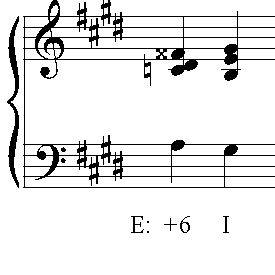
Building an augmented sixth on other scale tones:
You can use an augmented sixth chord much like you would use a secondary dominant – it gives you another way to “pull” towards a triad in the key. For example, you might wish to pull toward the tonic (but not do it by the traditional sound of using the dominant chord). Therefore you would set up an augmented 6th interval so that when it resolves outward by half steps, you arrive on the tonic note. For this to happen, we would need the leading tone, which will resolve up to the tonic, and the lowered 2nd scale degree, which will resolve down to the tonic. The chord can be one of the usual types. To find the other two notes, look carefully at the structure of the above types, analyzing the intervals between each note in the chord.
For example, we might wish to make a French type augmented sixth chord, where the augmented sixth would resolve outward to the tonic note. If we do this in the key of C, the notes of the augmented sixth interval would be D-flat and B. We need to find the other two notes in the chord. A French Aug 6th chord includes the tones low 6, 1, 2, and raised 4, making a sound like a V7 chord with a flatted fifth.
That means that since the D-flat is the bottom note of the augmented interval, it is the note that will sound like the “root “ of the (V7-flat 5) sound. Therefore the next note will be a major third above that (like the tonic note is above the low 6th scale degree), in this case F. The last note will be a M2 above that F, the note G. Let’s look at where those notes will resolve. Remember the D-flat and B both resolve to C. The F can move to the E, and the G can be a common tone.
| 